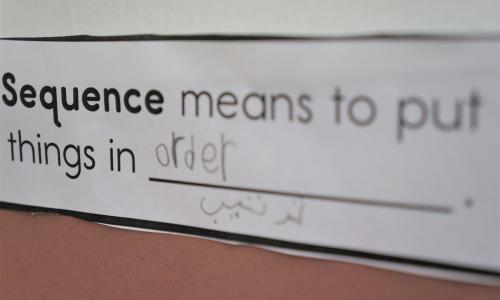Introduction
Research shows that vocabulary development is one of the most important skills students need to acquire to become English-proficient. Here are some strategies to help you get started! These strategies are geared towards grades 4-12 but can be adapted for younger students.
Related resources
Vocabulary Strategies for Educators
Teach vocabulary in an explicit, systematic way
Download these tips!
These tips are available as a one-page handout to download and print.
Choose the vocabulary that your students most need to know in order to support their reading development and content area learning. Plan for repeated exposures to ensure mastery. When introducing new vocabulary be sure to provide student-friendly definitions for words important to the task at hand.
Teach vocabulary thematically
Organize vocabulary around a common theme, and choose reading materials that reinforce that vocabulary in context.
Teach vocabulary by focusing on common root words and affixes to expand word knowledge
Learning about roots, prefixes, and suffixes is a great way to reinforce and expand ELLs' understanding of English words. Breaking the words down into smaller pieces makes unfamiliar words more comprehensible.
Capitalize on cognates
Teach students to make the connection between words that are the same or similar in English and in their primary language, also called cognates. This is an easy way to improve both vocabulary and reading comprehension.
Preview, preview, preview!
Before reading, pre-teach essential vocabulary and preview the content. "Walk" through the book or chapter, looking at the pictures and demonstrating how the previewed vocabulary is used in context since vocabulary is learned best through meaningful associations.
Teach and build academic vocabulary
English language learners need continued instruction in academic vocabulary as they encounter new subjects and new ideas at the high school level. Work with colleagues to identify and teach the vocabulary that ELLs need in order to be successful readers and learners in each of their other classes.
Teach vocabulary specific to content
A student's maximum level of reading comprehension is determined by his or her knowledge of words. Teach key words that children will need to comprehend texts, learn the content in those texts, and pass tests.
Ensure that your students learn the following dimensions of new words:
- The ability to define a word
- The ability to recognize when to use that word
- Knowledge of its multiple meanings
- The ability to decode and spell that word
Content-specific words include words such as 'photosynthesis', 'revolution', 'metaphor', and words with multiple meanings such as 'party', 'mouse', 'table', etc.
Teach signal words and directional words in order to build a student's academic vocabulary
Help ELLs learn how to recognize, understand, and use signal and directional words.
Signal words are sometimes called "transition" words and "signal" relationships between clauses. They include cause and effect words ("therefore" and "because"), comparison and contrast words ("despite" and "while", and time sequence words ("then and "before").
Directional words describe a language function students need to perform, such as "explain", "compare", "inform", "contrast", "persuade," "justify", etc.
Note: In J. Michael O'Malley & Lorraine Valdez Pierce's book, Authentic Assessment for English Language Learners, the academic and social language functions are laid out in a clear chart.
Differentiate between different kinds of academic vocabulary and usage
Help ELLs understand how to recognize and when to use different kinds of academic vocabulary (content-specific words, signal words, etc.) by making clear and specific distinctions between the different kinds of academic words students need to know for a specific topic.
Teach students how to use context clues to discover word meaning
Show students how to determine more meaning based on the rest of the sentence or surrounding paragraphs.
Give students multiple opportunities to work with vocabulary
This includes connecting vocabulary to personal experience, allowing students to use their primary language to make associations, using cognates, practicing speaking, reading and writing, using artwork to represent words, in addition to techniques such as Total Physical Response (TPR), which allows students to show what they know by acting it out.
Teach students to actively engage with vocabulary as they read
Underlining, highlighting, making notes, and listing unknown vocabulary words are just a few strategies that foster comprehension by helping ELLs actively engage with text.









Add new comment